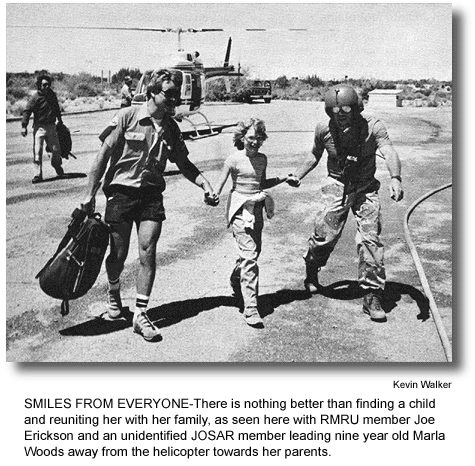Girl missing from campground
|
May 4, 1986 |
 |
By Bill Blaschko, M.D.
When I got the call at 9:30 on Sunday morning, I immediately had a sinking feeling. I was told that a 9 year old girl was missing at Joshua Tree National Monument UTNM) after she had gone to the bathroom near where her family was camping. The situation sounded much too similar to the case of Laura Bradbury, a little girl who has never been found after being reported as missing at JTNM and possibly being abducted. As I was driving to JTNM I thought about my own 9 year old daughter. It seemed unlikely to me that she would get lost under these circumstances. My sense of foreboding was relieved some-what when I entered JTNM. Roadblocks has been set up to check all traffic for the missing girl.
After arriving at base camp I discovered that the search for Marla Woods, our subject, was already well organized and underway. In addition to the roadblocks, the child's camp site had been roped of f to preserve tracks and we had an excellent description of Marla's clothing and foot- prints. A National Park volunteer, Robin Patterson, had already found a set of Maria's footprints leading out into the open desert. I had the good fortune of being teamed up with Joe Erickson and Robin with the assignment of following these tracks. As we meticulously followed Marla's trail, helicopters from Landells Aviation and El Toro Marine Base buzzed overhead. Also several other teams were put into the field by both RMRU and Joshua Tree Search and Rescue UOSAR). Enroute to the scene were members of the California Rescue Dog Association (CAR-DA) and Mountain Rescue Association teams from Sierra Madre, San Diego and Altadena.
Joe, Robin and I quickly settled into a smooth tracking routine. We were making slow but steady progress as we did not want to take any chance of inadvertently obliterating the prints. Kevin Walker, at base, radioed our group that a JOSAR team had come across tracks about a mile ahead of our location. Joe was flown ahead and verified that these were the subject's prints. Robin and I were then flown up to continue tracking with Joe. This process of "leapfrogging" saved hours of searching, and is a strategy our team commonly employs. Dale and Diane Smolenyak were the JOSAR members who found the prints while searching a dirt road. They joined us as we continued tracking.
By this time it appeared to be clear that Marla was lost in the desert, not kidnapped. The various ground teams and helicopters were directed to new assignments in the vicinity the tracks were leading towards. Tracking was intense work. I was bent over carefully studying a rock that had been turned over when I heard Diane yell out, "Marla!" As I continued to look at the ground, I remember thinking that it was a good idea to be calling out in hopes of making voice contact. A moment later I glanced up and saw Marla running into Diane's arms. When Joe asked Marla if she was all right she said, "I'm fine but I have one big problem, my parents are lost!" Don Landells flew in with Rob Gardner, picked up Marla and took her back to Cottonwood Camp. Back at base Marla explained that she had gone to a different bathroom than the one she had gone to the day before and got mixed up on the way back to her family's tent. While wandering in the desert she prayed to bolster her spirits.
 After Maria was reunited with her
family all the searchers met to discuss how
various aspects of the search went. I was
impressed with the rapid manner in which manpower
was mobilized. Searchers coming from all over
Southern California received updates on the
progress of the search every half hour over the
Bureau of Land Management repeater radio net-
work. Searchers from Northern California were
alerted and on standby if needed. Dog teams were
in the process of being flown in when Marla was
found. These were just some of the multi-agency
efforts that were mobilized within the first two
hours after Marla was reported missing. This kind
of team effort was no accident. It came out of
analyzing previous searches for good and bad
points. I felt that as painful as the Laura
Bradbury search had been, the lessons learned
there led to the rapid and successful recovery of
Marla Woods.
After Maria was reunited with her
family all the searchers met to discuss how
various aspects of the search went. I was
impressed with the rapid manner in which manpower
was mobilized. Searchers coming from all over
Southern California received updates on the
progress of the search every half hour over the
Bureau of Land Management repeater radio net-
work. Searchers from Northern California were
alerted and on standby if needed. Dog teams were
in the process of being flown in when Marla was
found. These were just some of the multi-agency
efforts that were mobilized within the first two
hours after Marla was reported missing. This kind
of team effort was no accident. It came out of
analyzing previous searches for good and bad
points. I felt that as painful as the Laura
Bradbury search had been, the lessons learned
there led to the rapid and successful recovery of
Marla Woods.